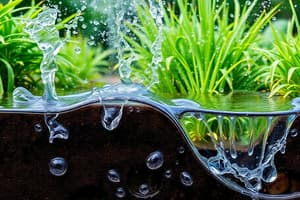Podcast
Questions and Answers
Asocia los procesos del ciclo del agua con sus descripciones:
Asocia los procesos del ciclo del agua con sus descripciones:
Evaporación = Transformación de agua líquida en vapor de agua Condensación = Transformación de vapor de agua en agua líquida Infiltración = Entrada de agua en el suelo desde la superficie Precipitación = Caída de agua del ambiente a la superficie terrestre
Asocia los factores que influyen en cada proceso del ciclo del agua:
Asocia los factores que influyen en cada proceso del ciclo del agua:
Evaporación = Temperatura, humedad, velocidad del viento Condensación = Enfriamiento del vapor de agua Infiltración = Porosidad del suelo Precipitación = Condición de densidad de las gotas de agua en nubes
Asocia el tipo de agua con su estado o forma en el ciclo del agua:
Asocia el tipo de agua con su estado o forma en el ciclo del agua:
Evaporación = Agua en estado líquido a gas Condensación = Vapor de agua a líquido Precipitación = Gotas de agua o cristales de hielo Escorrentía = Agua que fluye sobre la superficie terrestre
Asocia los términos con su significado dentro del ciclo del agua:
Asocia los términos con su significado dentro del ciclo del agua:
Asocia los fenómenos con su definición correcta:
Asocia los fenómenos con su definición correcta:
Asocia los tipos de agua con sus ejemplos:
Asocia los tipos de agua con sus ejemplos:
Asocia los procesos del ciclo del agua con su impacto ambiental:
Asocia los procesos del ciclo del agua con su impacto ambiental:
Asocia las características con los procesos del ciclo del agua:
Asocia las características con los procesos del ciclo del agua:
Flashcards
Evaporation
Evaporation
Liquid water turning into water vapor (gas) due to heat.
Condensation
Condensation
Water vapor turning back into liquid water due to cooling.
Infiltration
Infiltration
Water on the ground entering the soil.
Precipitation
Precipitation
Signup and view all the flashcards
Water Cycle
Water Cycle
Signup and view all the flashcards
Runoff
Runoff
Signup and view all the flashcards
Condensation Nuclei
Condensation Nuclei
Signup and view all the flashcards
Porosity of Soil
Porosity of Soil
Signup and view all the flashcards
Study Notes
The Water Cycle
- The water cycle, also known as the hydrologic cycle, is a continuous process that describes the movement of water on, above, and below the surface of the Earth.
- It involves a series of interconnected processes that constantly recycle water throughout the environment.
Evaporation
- Evaporation is the process by which liquid water transforms into water vapor (gas).
- This conversion occurs when the sun's energy provides enough heat to overcome the water's attractive forces, allowing water molecules to escape into the atmosphere.
- Evaporation can take place from any surface with liquid water, including oceans, lakes, rivers, and even soil.
- The rate of evaporation is influenced by factors such as temperature, humidity, wind speed, and sunlight intensity.
- Higher temperatures, lower humidity, and stronger winds generally increase the rate of evaporation.
Condensation
- Condensation is the process by which water vapor transforms back into liquid water.
- This occurs when water vapor cools down and loses energy.
- As the air temperature decreases, water vapor molecules lose kinetic energy and begin to condense around tiny particles in the air (condensation nuclei).
- These nuclei can be dust, salt, or other aerosols.
- Condensation is crucial in the formation of clouds and eventually precipitation.
Infiltration
- Infiltration is the process by which water on the ground surface enters the soil.
- It's driven by gravity and the presence of spaces within the soil.
- The rate of infiltration depends on the type of soil, its porosity (amount of pore space), and the amount of water already present in the soil.
- High porosity soils and low water saturation generally lead to faster infiltration.
- Some water may also percolate deeper into the ground, eventually reaching groundwater reservoirs.
Precipitation
- Precipitation is any form of water that falls from the atmosphere to the Earth's surface.
- This includes rain, snow, sleet, and hail.
- Precipitation results from the condensation of water vapor in clouds, which eventually becomes too dense to remain suspended in the air.
- Gravity pulls the condensed water droplets or ice crystals to the ground as precipitation.
- The type of precipitation depends on the air temperature at different altitudes throughout the atmosphere.
Runoff (Surface Runoff/River Run-off)
- Runoff, or surface runoff, is the flow of water over the Earth's surface.
- This occurs when precipitation exceeds the infiltration capacity of the soil, leaving excess water to flow over the land.
- Runoff can contribute to erosion and the transport of sediment and pollutants.
- Runoff can also feed into streams, rivers, and eventually larger bodies of water like lakes and oceans.
- The rate of runoff is affected by factors such as topography, vegetation cover, and the intensity of precipitation.
- Areas with steep slopes and sparse vegetation generally have higher rates of runoff.
Studying That Suits You
Use AI to generate personalized quizzes and flashcards to suit your learning preferences.




